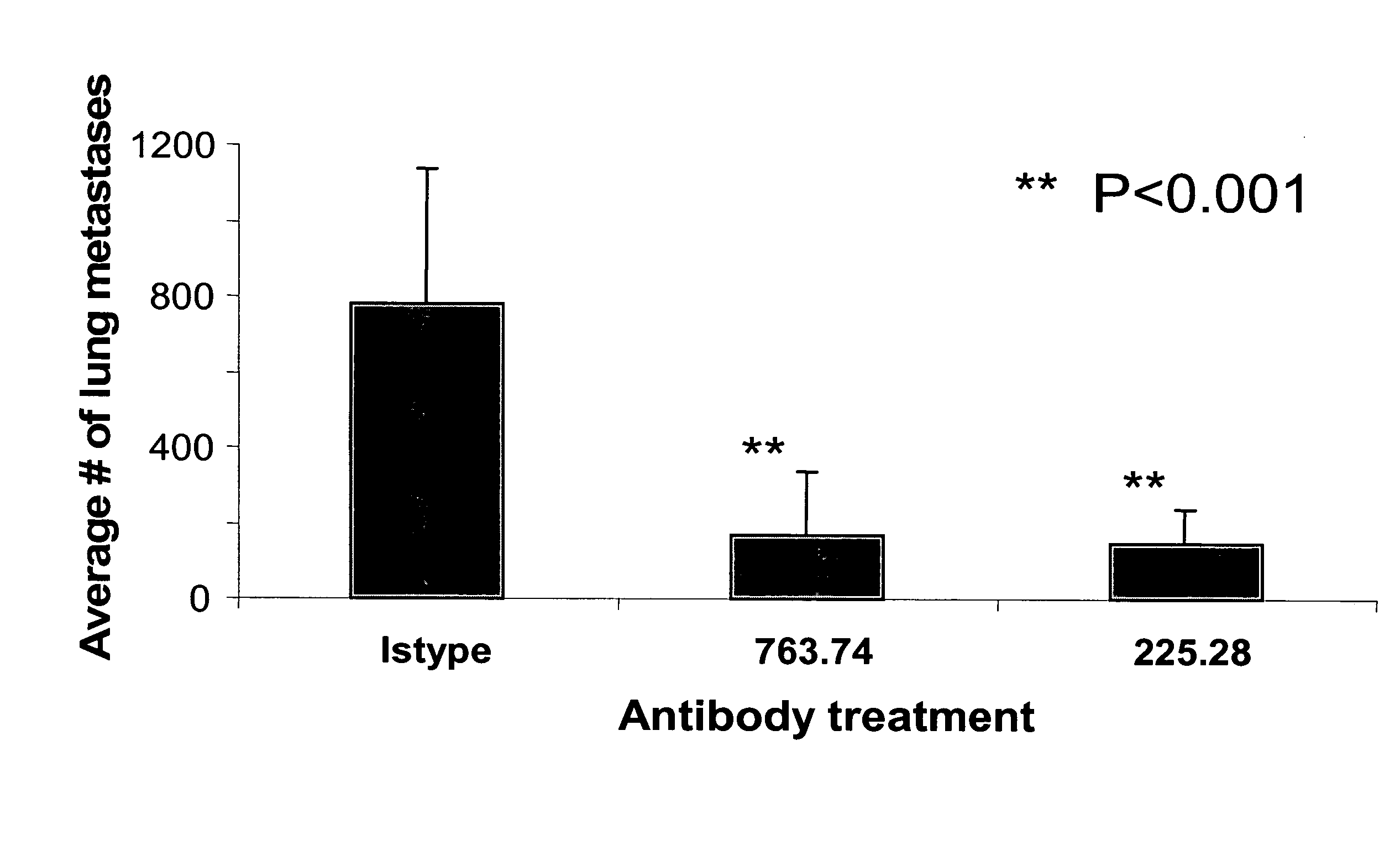Inhibition of breast carcinoma stem cell growth and metastasis
a breast carcinoma and stem cell technology, applied in the field of cancer, can solve the problems of limited therapeutic resources, and achieve the effect of inhibiting the growth of breast carcinoma stem cells
- Summary
- Abstract
- Description
- Claims
- Application Information
AI Technical Summary
Benefits of technology
Problems solved by technology
Method used
Image
Examples
example 1
[0032] This Example demonstrates HMW-MAA expression by a subpopulation of breast carcinoma stem cells in breast carcinoma stem cell lines.
[0033] Staining of seven human breast carcinoma cell lines (FIGS. 1A and 1B) with the HMW-MAA-specific mAb 763.74, TP61.5 and VF1-TP41.2 demonstrates that at least 80% of the CD44+, CD24 lo cells were stained by HMW-MAA-specific mAb in the cell lines MDA-MB-435, about 70 and 50% in the cell lines MDA-MB-231 and HS578T, respectively, and less than 4% in the cell line MCF-7 and SUM-149. It is noteworthy that the percentage of CD44+, CD24 lo cells stained by the three HMW-MAA-specific mAb is stable across multiple cell culture passages, which indicates that the expression of HMW-MAA by breast carcinoma stem cells is a stable characteristic.
example 2
[0034] This Example demonstrates the molecular profile of HMW-MAA expressed by breast carcinoma stem cells. To characterize the molecular basis of the staining of breast carcinoma stem cells by HMW-MAA-specific mAb, a lysate of the human breast carcinoma cell line MDA-MB-435 was tested with mAb 763.74 in Western blotting. Specifically, and as shown in FIG. 2, a lysate from CD44+CD24lo breast carcinoma cells MDA-MB-435 was separated by 8% SDS-polyacrylamide gel for immunoblot analysis with HMW-MAA-specific mAb 763.74 (lane 3) and isotype control mAb MK2-23 (lane 6). Human melanoma cells M14, which do not express HMW-MAA (lanes 1 and 4), and M14 / HMW cells, which express HMW-MAA following HMW-MAA cDNA transfection (lanes 2 and 5), were used as controls. The two characteristic components of the HMW-MAA were identified as depicted in FIG. 2.
example 3
[0035] This Example demonstrates HMW-MAA expression by CD44+ / CD24− / low breast carcinoma stem cells in the human breast cancer cell line MDA-MB-435s. As depicted in FIG. 3A, staining of MDA-MB-435s cells with CD24−,CD44-specific mAbs showed that >80% of cells are CD44+ / CD24− / low breast carcinoma stem cells as indicated. As shown in FIG. 3B, staining of CD44+ / CD24− / low putative breast carcinoma stem cells with HMW-MAA-specific mAb 225.28 (bottom panel) and with an isotype control mAb (top panel) showed that 99.1% of CSC are HMW-MAA positive. Thus, a human breast cancer stem cell line is demonstrated to express HMW-MAA.
PUM
| Property | Measurement | Unit |
|---|---|---|
| Fraction | aaaaa | aaaaa |
| Fraction | aaaaa | aaaaa |
| Fraction | aaaaa | aaaaa |
Abstract
Description
Claims
Application Information
 Login to View More
Login to View More - R&D
- Intellectual Property
- Life Sciences
- Materials
- Tech Scout
- Unparalleled Data Quality
- Higher Quality Content
- 60% Fewer Hallucinations
Browse by: Latest US Patents, China's latest patents, Technical Efficacy Thesaurus, Application Domain, Technology Topic, Popular Technical Reports.
© 2025 PatSnap. All rights reserved.Legal|Privacy policy|Modern Slavery Act Transparency Statement|Sitemap|About US| Contact US: help@patsnap.com



